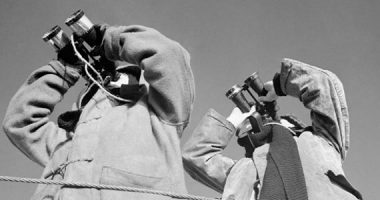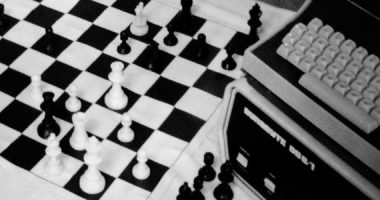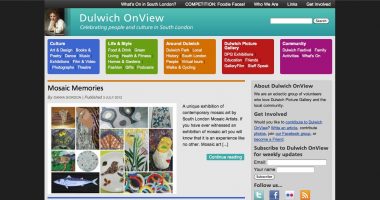
Aerial View of Elephant in National Museum of Natural History’s Rotunda, 1981. The Smithsonian Institution Archives. No known copyright restrictions.
I return to work after the Museums and the Web Los Angeles conference, an intense week of debates and conversations around digital change in galleries, libraries, archives and museums. When my colleagues ask me how it went, I find it hard to give them a short answer that sums up everything I’ve learnt and experienced. Until someone invents an app or magic potion that makes us ubiquitous, it is impossible to follow an event with a program so full of all kinds of activities, many of them taking place simultaneously. The four-day programme featured twenty workshops, over thirty demonstrations, and more than a hundred talks, including lectures, papers, projects, professional breakfasts and lunches, storytelling sessions, forums and practical sessions. On top of that, participants could visit the Exhibit Hall and a digital art exhibition, and, at the end of these jam-packed days, attend receptions at the fabulous The Broad contemporary art museum and the Natural Museum of Los Angels. Around 800 attendees representing 467 cultural institutions from 32 different countries participated in this extensive programme of activities, with a majority (as you would expect) from the United States.
David Beaman and Jennifer Trant, co-founders of Museums and the Web in 1997, explained that even though twenty years have gone by since the first conference, the subjects that interest the professional community remain the same: how to put collections online, the educational purpose of museums, how to programme and design user-centred projects, etc. Technology can provide solutions along these lines, but it is not the essential element. «Digital change in museums is organisational», said one of the tweets that made the rounds during the conference. As we’ve already seen in previous articles on this blog, we shouldn’t be blinkered by social media or by the technology gadgets available on the market. Institutions are facing processes of change that affect all areas (not just digital departments) and users are at the centre of this transformation. The key lies in knowing the role and the strategy of your organisation in this changing context.
This article summarises some of the topics explored during MWXX. It is an attempt to synthesise the ideas that struck me as particularly interesting. You will find that some of the talks and projects presented in Los Angeles are missing here, but luckily the Museum and the Web website is publishing all the papers that have been presented in its twenty-year history. I urge you to look at this year’s program and plunge into the historical archive (a little bit difficult to navigate, truth be told), because it is an excellent source of documentation on the problems and lines of work of twenty-first century museums.
State of surveillance and privacy. What role do museums play?
Cyberactivist and founder of online magazine Boing Boing, Cory Doctorow gave a conference with a lecture on the economy of mass-surveillance, a problem that is global in scope, he said. In a connected world, where virtually all our social interactions can be traced and monitored, and where it is increasingly easy for companies to get their hands on our personal data, what should be the role of citizens and museums? Doctorow warned of the the importance of acting responsibly in regard to our data (for example, choosing systems and devices that don’t force users to install software on their devices without permission) and urged cultural institutions to act with maximum transparency and prudence in regards to visitor data. This recommendation, however, is at odds with another of the key topics of Museums and the Webs: the increasingly sophisticated collection of visitor data.
Data and More Data. Why do we measure?
Do we really need to collect so much data about visitors in order to improve the user experience? Are we adequately informing visitors about the way we use their personal details? Data was one of the hot topics of the conference: from workshops on analysis applied to the web and/or social networks, data visualisation and open data, to presentations of papers in The (big) Data session, and talks about the way organisations are managing enormous databases, crossing information and trying to draw useful, intelligible conclusions.
In the Metrics, Metrics, Everywhere workshop led by Brian Alpert, Sarah Banks, Erin Marie Blasco and Effie Kapsalis (professionals working at different branches of the Smithsonian Institution), we learnt that the most practical way to avoid going crazy when we measure (and show our bosses!) the impact of websites and social media is to apply a simple, regular analysis methodology. Their advice included: have a clear idea of the objectives of the project or programme that you are disseminating, decide what strategies to use and the best tactics with which to implement them, choose what to measure and why, and decide on (a few) indicators to evaluate these tactics. They also recommended collecting data during a period of at least six months, so as to gain some perspective on the campaign you are analysing. The powerpoint presentation used in this workshop is available online, as is the one used in the course imparted by Elena Villaespesa from the Metropolitan Museum in New York, who is considered one of the top experts in web analytics in the cultural sector.
In regard to the management of data on a mass scale and its effects on the work routines of museum staff, I recommend the paper by Micah Walter from the Cooper Hewitt Smithsonian Design Museum. You can read more about the presentation in this post published by the Cooper Hewitt Lab.
Are we viral yet?
I attended a talk by Angelica Aboulhosn (Brookings Institution) entitled Contagious: Why Museum Campaigns Go Viral hoping to find a convincing and conclusive answer to the question that many people working in digital communication have asked ourselves: Is this content viral yet? Disseminating ideas that are emotional/humorous and have a practical value, and generating a collective narrative and conversation (through the remix of works, for example) are strategies that boost the impact of your content and increase the probability that it will go viral. Examples of museum campaigns include #5WomenArtists, #ArtMadness, #GIFItUp (GIFs are a trending topic), Vangoyourself (recreation of artworks by groups of friends), #NGADrawingSalon, The Next Rembrandt, Connections of the Met.
Content that is open, accessible, and available to all
«We need to take the content to the people, de-instutionalise it, and facilitate its reuse», said Museum and the Web founders David Bearman and Jennifer Trant during their talk at MWXX. This is a challenge that can provide clues when it comes to planning what we can and want to do with our collections and archives, regardless of whether they exist in physical or digital form. There were many presentations on the design of search engines and user-friendly interfaces that make it easy for visitors to search museum collections and find what they are interested in. In Los Angeles, the head of digital development at the Museo del Prado, Javier Pantoja, presented the Madrid museum’s website, which is based on a semantic model that allows more intuitive searches of the works in the collections, the artists, and other related content. You can find out more about the Prado’s semantic website, which recently won one of the prestigious Webby awards for the best projects on the internet.
The importance of inclusive design (a step beyond accessibility in the museum, which aims to ensure that all content reaches all kinds of users) was discussed in an interesting presentation by Corey Timpson, who talked about how the Canadian Museum for Human Rights is working with an inclusive approach on all elements that are designed within the museum: from the physical spaces of the museum to the exhibitions (posters and materials exhibited) to the website and communication.
Storytelling and content strategy
A good strategy for improving the visitor experience is to work on communicating the content of projects, both in digital and physical formats. In some museums, this work is carried out by Interpretive Media teams – professionals who come up with the narratives that each project needs, and decide on the most appropriate media (posters, website, leaflets, adioguides, minisites) by which to make each cultural or exhibition project intelligible and appealing to users. Even though I work in the field of cultural content creation, I have to admit that I wasn’t aware of the existence of departments dedicated to these tasks. One of the workshops I attended at MWXX allowed me to immerse myself in the world of interpretive media.
Before starting to build a project from the roof down, based on requests that only focus on the technology («We want a website for the exhibition» or «We want an app for the museum») it is essential to discover the interests of the audience you are addressing, to know what content you have at your disposal (or if it is necessary to generate new content), and to set objectives. Then you can choose the most appropriate channels and media to make your story reach its target. Storytelling and the the co-creation of projects with audiences are some of the recurring topics that came up in many other talks at the conference, which I unfortunately could not attend because they overlapped with other sessions.
Mobile
I liked what Catherine Devine said about the evolution of web design for mobiles, which means not just being content with the responsive versions of museum websites. When it comes to designing mobile apps or websites, we should take into account the daily routines of people who use mobiles, the «moments» at which they use their device: you wake up (check the time on the mobile), catch a flight (look at your ticket on your mobile), order a taxi (call on the mobile). We should integrate the museum experience into the everyday use of mobiles, as another regular use among many.
Museums become digital: strategic changes in cultural institutions
Sebastian Chan (Australian Centre for the Moving Image), Timothy Hart (Museum Victoria), Nancy Proctor (Baltimore Museum of Art) and Carolyn Roston (Isabella Stewart Gardner Museum) are all experts who have headed processes of organisational change in museums. In a professional forum, they talked about the complexity of convincing museum staff and, particularly, management of the need to change working methods and processes. Showing that the changes implemented in a digital strategy will be successful, and doing it in a time-frame that is not too long (they talked about six months) are two elements to bear in mind, according to the speakers, as is digital literacy, another of the topics featured at MWWXX.
Another forum focused on the importance of ensuring that all departments in a museum «think digital». How can this change of mentality be achieved? Providing the necessary tools and training, establishing better methods for interdepartmental collaboration, and generating new workflows were some of the ideas that came up, which can be found in a document created collaboratively during the congress: Visions:matrix.
Playlist of special moments and personal notes
I don’t want to finish this article without sharing some of my personal MWXX-Los Angeles margin notes, impressions, and experiences.
- “Lighting talks” and “How-To” sessions. I was very impressed by these brief, fast presentations, targeted at professional practice and the use of tools and techniques to improve videos, mobile apps, online projects, etc. Thanks to a citizen science project organised by the Natural History Museum of Los Angeles I discovered Inaturalist.org, an open source social network that allows anybody to post nature-related photographs and resources and share and discuss them with scientists and naturalists.
- I expected something else from… Web Crit, the session in which website design and usability experts analyse and review museum websites with a critical spirit. They only analysed four websites, and the crits were a bit long (maybe there was no need to make so many funny comments about the navigation, which were stoically endured by the representatives of the websites who were present in the room). Perhaps a more systematised analysis methodology would make it possible to crit more projects.
- A second (small) disappointment: The CCCB Lab blog, nominated for the GLAMi Awards for the best online cultural projects, did not win any award. Even so, the GLAMis are always a good opportunity to discover interesting projects, like the British Art Studies online journal on British art, which won the People’s Choice GLAMi.
- A unique experience: sitting down to dinner among the wonderful, dreamlike animal dioramas at the Museum of Natural History in Los Angeles, which hosted one of the conference receptions, and wondering among the skeletons of giant dinosaurs.
- I will never forget: The Millenium Biltmore Hotel, the peculiar hotel where the conference was held and were most delegates stayed is a landmark mentioned in Los Angeles tourist guides that deserves and article of its own. It is a fascinating and cinematographic place (the first Oscars ceremonies were held there) with endless hallways, eerie background music, stairways that lead to unexpected exits, no natural light, and many rooms with floors covered in carpets with floral motifs.
- Acknowledgements: I was able to attend Museums and the Web Los Angeles thanks to a grant awarded by the conference sponsors. I would like to thank them and the whole MWXX team (particularly Hiroko Kusano and Nancy Proctor for their welcome and support) for making this highly enriching experience possible. See you next time!





Carlos | 14 September 2016
Buenos días, Lucía.
No sólo existen empresas como Interpretive, que desarrollan una estrategia de contenidos omnicanal, sino que también existimos los que las diseñamos y supervisamos externamente, cuando el mensaje supera el ámbito propio de la exhibición y tarea museística.
Quizá te pueda interesar http://www.estrategiadelcontenido.com/post.php?pag=la_aportacion_un_museo_estonio_la_estrategia_contenidos_institucional
La experiencia de este museo nacional etnográfico a lo largo de cuatro años marca absoluta tendencia en la forma de abordar el contenido.
Un saludo
Leave a comment